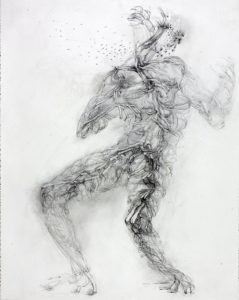Where Art & Science Meet: The AISLE Project

Brigham Dimick. Arboreal Anatomy. Charcoal & Conte. 52” x 42″. 2004.
Outside of teaching courses in biology, Southern Illinois University Edwardsville professor Dr. David Jennings has spent a considerable amount of time developing and launching the AISLE Project. An acronym for “Active Integrative Synergistic Learning Environments,” the project began as a way to promote an exchange of ideas across multiple disciplines through use of Bluetooth technology around campus.
Initially funded by The College of Arts & Sciences’ Targeted Funding Initiative, the project is at the intersection of science and art and was made possible through a collaboration between Jennings and University Museum Collections Manager, Erin Vigneau-Dimick. Located in Science Building East and Science Building West, AISLE includes thirty pieces of artwork from the University Museum’s collections, student works from Sculpture on Campus, and loaned artwork from Art & Design Faculty members associated with topics in science. The installation of works was facilitated by the University Museum with undergraduate students having a hand in the selection process and graduate assistants working with museum staff on the curation and installation.
“It was important that the project involve students because there is actually a lot that goes into displaying artwork–AISLE enabled students to get hands on experience with curating and installing artwork, a major goal of the museum,” said Vigneau-Dimick.
The more technological side of the project involves the use of a free application called Phy, which can easily be downloaded to any smart device and when the app is open, users are notified of when an AISLE project related artwork is within vicinity.
“I have been thinking about this project for around four years now. Getting a better handle on the technology has really made this project a reality,” said Jennings, as he showed how easily the app worked from his iPad.
All of this is made possible with a small piece of technology called a beacon, or radio transmitter. Beacons are typically placed out of sight and involve multiple pieces within an area. Each beacon sends out a signal, and when a user is nearby, they can obtain information pertaining to those works.
“So far this project has generated a lot of enthusiasm from students and faculty alike–it has been really great to see numerous biologists engaging in a conversation about the sculpture downstairs,” commented Jennings. Vigneau-Dimick further attested to the project’s ability to connect people through art, “Since the installation, the project has generated a lot of discussions. The work does not always make people feel comfortable, it is not always perceived as beautiful, but people are really looking, thinking, and talking about the art.”
AISLE has also initiated a lot of conversation across departments and it has the potential to transform the entire campus into an integrative learning environment. While the project includes only links to artwork at this time, it is not limited to only artwork, as Jennings remarked, “There is no limit to what information you can link to a beacon–there are so many other possibilities for its use.”
Filed Under: Art and Design • Biological Sciences • Faculty News












